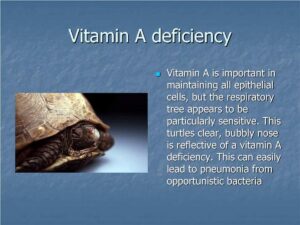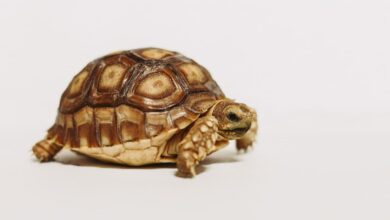Vitamin “A” Deficiency In Turtles
When turtles don’t get enough Vitamin A in their food, they develop Vitamin A deficiency (also known as hypovitaminosis A), which causes problems with their skin and other organs.
Vitamin A insufficiency is common in turtles when they are kept as pets. Vitamin A is required to develop healthy skin, mucous membranes, and ducts within the turtle’s organs. Suppose turtles do not obtain enough Vitamin A. In that case, they will develop squamous metaplasia, which will prevent the turtle’s skin or organs from performing their normal functions, most commonly by blocking fluid flow through ducts.
Vitamin A insufficiency is widespread in young semi-aquatic turtles and box turtles over six months of age. Tortoises are rarely deficient in Vitamin A because their diet naturally includes vitamin-rich plants. The shortage is seldom seen in children under six months because the yolk typically contains enough Vitamin for a few months of nourishment.
Symptoms of Vitamin A Deficiency in Turtles
When a turtle is deficient in Vitamin A, the following symptoms may appear:
- Turtle eyelids could be swollen.
- Turtles lose weight and become uninterested in meals.
- Turtle also develops a mouth infection.
- Turtles have a lot of respiratory illnesses.
The most visible sign of a Vitamin A deficiency is swollen eyelids. Because this could signify a bacterial infection in the turtle’s eyes or respiratory tract, the veterinarian will want to figure out what is causing the problem before starting therapy.
Stomatitis, pneumonia, and otitis are only a few problems linked to a lack of vitamin A in turtles. Treatment for these illnesses is generally ineffective until the Vitamin A deficiency is corrected.
Causes of Vitamin A Deficiency in Turtles
Turtle’s Vitamin A deficiency, also known as Hypovitaminosis A, is caused by a lack of Vitamin A in his diet. Turtle’s body needs Vitamin A for mucous membranes, healthy skin, and ducts (small tubes that allow fluids like saliva, urine, or bile to pass through) within their organs; if they do not get enough of it, their cells will grow abnormally thick and thicken. As a result, the natural function of the skin or organs will be disrupted.

Diagnosis of Vitamin A Deficiency in Turtles
You should take your turtle to the veterinarian if you observe any alarming symptoms in him. An eye exam and an oral exam will be performed as part of the physical assessment. The veterinarian will want to know about your turtle’s medical history, any symptoms that have been noticed, and his food, as well as any supplements he takes. The symptoms of a Vitamin A deficiency are similar to those of other diseases. Veterinarians will want to rule out other possible causes for your turtle’s symptoms before diagnosing it.
Bacterial infections are a common side effect of Vitamin A deficiency in turtles. A complete blood count (CBC) and a serum or plasma chemistry panel will be performed. This will assist you in figuring out if your turtle has any underlying illnesses or organ involvement.
Your veterinarian may recommend a biopsy of any abnormal skin on your turtle. Your veterinarian will sift through the skin sample to see if the irregularities are caused by extra keratin caused by a Vitamin A deficiency.
Treatment of Vitamin A Deficiency in Turtles
If your turtle is diagnosed with a Vitamin A deficiency, you have to improve the turtle’s diet to ensure that he gets adequate Vitamin A. It is a critical part of the turtle’s treatment. Your veterinarian may recommend a supplement for your turtle to take while his diet is changed. As time passes, the amount of complement that turtle takes will be reduced because too much supplement might cause toxicity.
Recovery of Vitamin A Deficiency in Turtles
You have to make sure that your turtle eats a balanced diet that includes plenty of Vitamin A. Dark, leafy greens, yellow or orange veggies, and live fish usually contain enough Vitamin A to suit your turtle’s nutritional requirements.





